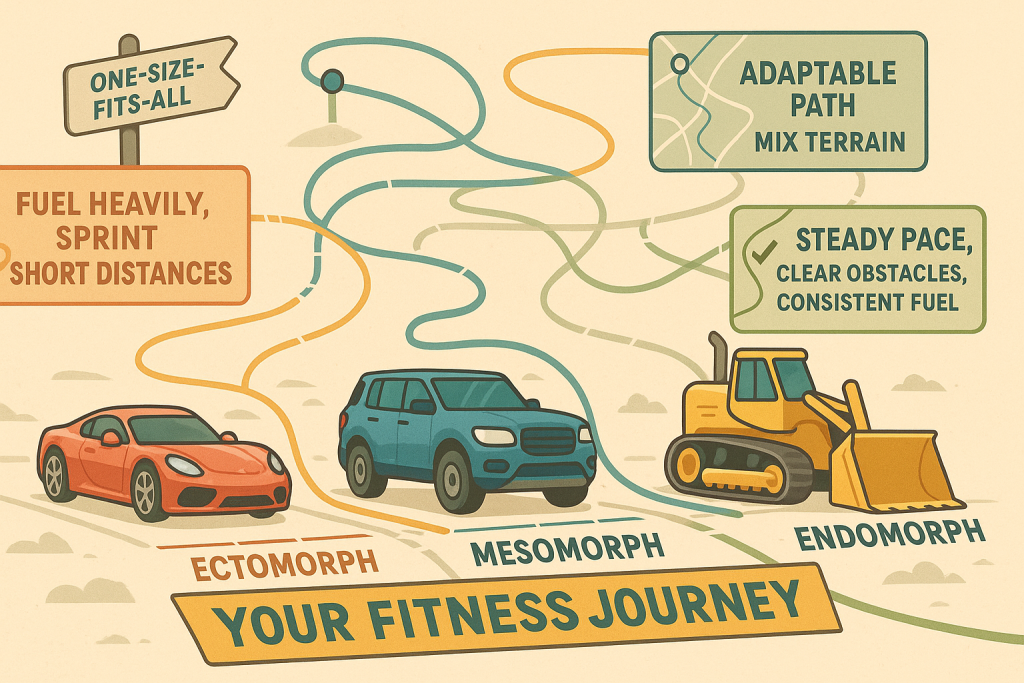
In the pursuit of fitness, we often search for a one-size-fits-all solution. We see a workout and diet that worked for a friend and try to force our bodies into the same mold, often with frustrating results. This is where the concept of somatotypes—commonly known as body types—comes in. Understanding whether you lean towards being an Ectomorph, Mesomorph, or Endomorph isn’t about putting yourself in a box with a label. It’s about unlocking a personalized blueprint that tells you how your body likely responds to food and exercise, allowing you to work *with* your genetics, not against them.
It’s crucial to note that these are general frameworks. Most people are a blend of two types. However, identifying your dominant tendency can be a game-changer for your strategy.
1. The Ectomorph: The “Hardgainer”
Characteristics: Naturally thin, lean, with a light build, small joints, and long limbs. They have a fast metabolism and find it difficult to gain both muscle and fat.
The Struggle: Building muscle mass can feel like an uphill battle. They can feel like they’re eating constantly but see minimal gains on the scale or in the mirror.
Your Fitness & Nutrition Blueprint:
Training Focus: Less is More. Ectomorphs have a nervous system that is easily stressed. Long, frequent cardio sessions can burn the precious calories needed for muscle growth. Focus on shorter, intense strength training sessions (3-4 times per week) centered on compound lifts like squats, deadlifts, and bench presses. Keep cardio to a minimum or on separate days.
Nutrition Focus: Caloric Surplus. You need to eat more than you think. Prioritize calorie-dense, nutrient-rich foods. Don’t be afraid of carbohydrates like oats, rice, and potatoes to fuel your workouts and recovery. Protein intake is critical. Have a protein shake with a banana and peanut butter if you struggle to eat enough.
2. The Mesomorph: The “Athlete”
Characteristics: Naturally athletic and muscular build. They have a medium-sized frame, broad shoulders, a narrow waist, and gain muscle and lose fat with relative ease compared to the other types.
The Struggle: The mesomorph’s blessing can also be a curse if they become complacent. While they gain muscle easily, they can also gain fat more easily than an ectomorph if their diet becomes careless.
Your Fitness & Nutrition Blueprint:
Training Focus: Variety and Balance. Mesomorphs respond well to almost any type of training. The key is to avoid adaptation by mixing it up. A blend of strength training (4-5 times per week), HIIT (High-Intensity Interval Training), and sports will yield fantastic results. They can handle more volume and frequency than ectomorphs.
Nutrition Focus: Moderate and Balanced. A mesomorph typically thrives on a balanced macronutrient split—adequate protein, carbohydrates for energy, and healthy fats. They don’t usually need to be as extreme with their calorie intake as the other types, but portion control and food quality are essential for staying lean.
3. The Endomorph: The “Stockier” Build
Characteristics: Softer, rounder body with a larger bone structure. They tend to have a slower metabolism, store fat more easily (particularly around the midsection), and find it harder to lose weight, though they can often build muscle reasonably well.
The Struggle: The battle is often won or lost in the kitchen. A calorie-dense diet will quickly show up on the scale. Endomorphs can feel like they have to work twice as hard for half the results.
Your Fitness & Nutrition Blueprint:
Training Focus: High Frequency and Activity. Endomorphs need to focus on stoking their metabolic fire. This means a combination of effective strength training (3-4 times per week to preserve and build metabolism-boosting muscle) and regular cardio. Steady-state cardio like walking, cycling, or swimming is important, but HIIT can be particularly effective for burning calories and improving insulin sensitivity.
Nutrition Focus: Quality and Caloric Awareness. The endomorph body type is often more sensitive to carbohydrates, especially refined carbs and sugars. Focus on a diet rich in lean proteins, fibrous vegetables, and healthy fats. Be mindful of portion sizes and overall calorie intake to create a consistent, slight deficit for fat loss.
The Most Important Takeaway
Your somatotype is a starting point for self-discovery, not a life sentence. It provides powerful clues, but it doesn’t override the universal principles of consistency, effort, and a positive mindset. Use this framework to tailor your approach. Stop fighting your genetics and start leveraging them. When you train and eat for your unique body type, you stop spinning your wheels and start accelerating toward the results you deserve.
